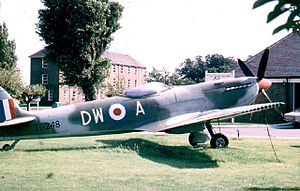RAF Sealand
| MoD Sealand RAF Shotwick |
|
|---|---|
| Part of Flintshire | |
| Queensferry in Wales | |

Spitfire LF16 gate guardian on display at RAF Sealand's East Camp in 1975.
|
|
|
Shown within Wales
|
|
| Coordinates | 53°13′17″N 003°00′24″W / 53.22139°N 3.00667°WCoordinates: 53°13′17″N 003°00′24″W / 53.22139°N 3.00667°W |
| Type | Royal Air Force station |
| Site information | |
| Owner | Ministry of Defence |
| Operator |
Royal Flying Corps (1916–1918) Royal Air Force (1918–1951) United States Air Forces In Europe (1951–1957) Royal Air Force (1957–2004) |
| Site history | |
| Built | 1916 |
| In use | 1916–2004 |
| Battles/wars | European Theatre of the Second World War (RAF) |
| Airfield information | |
| Elevation | 5 metres (16 ft) AMSL |
MOD Sealand is a civilian Ministry of Defence installation in Flintshire, in the north-east corner of Wales, close to the border with England. It is a former Royal Air Force station, active between 1916 and 2006.
Under defence cuts announced in 2004 RAF Sealand was completely closed in April 2006. All remaining RAF units were moved to RAF Leeming. Part of the original airfield is now operated as the civilian MoD installation.
Clwyd-Powys Archaeological Trust says the site is nationally important as it became home in 1916 to a flying school which, during World War I, was requisitioned by the War Office becoming RAF Sealand In 1924. The report said: "The site of the former Dutton's Flying School is an incredibly important historical location, effectively the origin point of the initial Royal Flying Corps and later RAF as a fighting force. "The degree to which any traces of Dutton's aerodrome survive as sub-surface deposits is currently unknown as there have been no investigative works. " The trust hopes the area can be excavated as part of the site's development.
It was originally a civilian airfield and was taken over by the military in 1916 for training. Two twin hangars, which were built in 1917, were used by the newly formed Royal Flying Corps. Originally named RFCS Shotwick and later RAF Shotwick, the station was finally named RAF Sealand during the Second World War.
Immediately pre-war and in the early war years, it was the home of No. 5 Flying Training School RAF (5 FTS), equipped with Airspeed Oxfords. During the war, the Flying Training Schools provided what was in effect intermediate training for pilots who had received ab initio training and flown solo at an EFTS (Elementary Flying Training School) and who had subsequently been inducted into the RAF. Pilots thus arrived at No. 5 FTS RAF Sealand as APOs (Acting Pilot Officers) and upon satisfactory completion of intermediate training became Pilot Officers (POs), and were prepared for posting to a squadron or OTU (Operational Training Unit). Kenneth Cross spent time at No. 5 FTS as an instructor in the early 1930s. From 5 August 1940, the CFI (Chief Flying Instructor) was Edward Mortlock Donaldson. Amongst the pilots who trained at 5 FTS, RAF Sealand was Johnnie Johnson.
...
Wikipedia

